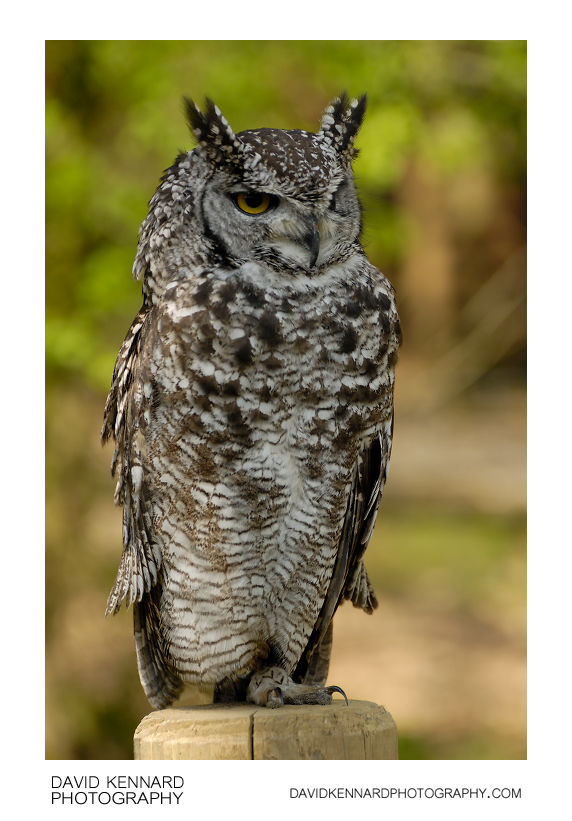Spotted Eagle Owl (Bubo africanus)

Description
- Title:
- Spotted Eagle Owl (Bubo africanus)
- Caption / Description:
-
The Spotted Eagle-owl (Bubo africanus) is a medium-sized species of owl, one of the smallest of the Eagle owls. Its height is forty-five cm (18 inch) and its weight is from 480 to 850g (1 to 1.8 pounds). It has a 33cm (13 in) wingspan. The facial disk is off white to pale ochre and the eyes are yellow. It has prominent ear tufts, and the upper body is dusky brown, the lower parts off-white with brown bars. Prior to 1999 the Spotted Eagle-owl was considered conspecific with the Vermiculated Eagle-owl, but now it is classed as a separate species. Its prey consists of small mammals, birds, insects and reptiles.
Spotted at the trey inhabit most of Africa south of the Sahara desert away from dense forests. They are diurnal hunters, spending the night concealed in trees, rock ledges or abandoned burrows. They are found in areas with rocky outcroppings, scrub land, open woods, and semi deserts. Spotted Eagle-owls do not avoid populated areas. They often hunt near roads and are often struck by vehicles. The major cause of death is pesticides used in agriculture for insect and rodent control.
Spotted Eagle-owls mate for life. They are able to breed at around one year of age. They make their nest on the ground and have been known to nest on window ledges of buildings. Breeding begins in July continuing to the first weeks of February. The female lays two to four eggs and does the incubation, leaving the nest only to eat what the male has brought food. The incubation period lasts approximately 32 days. The young owls can fly at around seven weeks of age. Five weeks later, the young owls leave the nest. They have a life span of up to ten years in the wild and up to twenty in captivity.
Description from Wikipedia: http://en.wikipedia.org/wiki/Bubo_africanus
- Tags / Keywords:
-
- Biota
- Life
- Vitae
- Eukaryota
- Animalia
- Animals
- Chordata
- Chordates
- Aves
- Birds
- Strigiformes
- Owls
- Strigidae
- Typical owls
- True Owls
- Bubo
- Horned Owls
- Eagle Owls
- Bubo africanus
- Spotted Eagle Owl
Admin
- Date Original Photo Taken:
- Original File Name:
- _DSC8789.nef
- Event:
- Rating:
- ☆
- Date this image added/last updated on website:
- Original File Dimensions:
- 2592px x 3872px
- File Type:
- JPEG
- Color Mode:
- RGB
- Original Image Color Profile:
- Nikon Adobe RGB 4.0.0.3001
Location
- Location Shown:
-
- Sublocation:
- Rutland Falconry & Owl Centre
- City:
- Oakham
- Province/State:
- Rutland
- Country:
- United Kingdom
- World Region:
- Europe
- Location Created:
-
- Sublocation:
- Rutland Falconry & Owl Centre
- City:
- Oakham
- Province/State:
- Rutland
- Country:
- United Kingdom
- World Region:
- Europe
- Geo-location:
- 52.681941723592, -0.66310693146389 View on map
Rights
- Copyright Status:
- Copyrighted
- Licensing Status:
- Rights Managed
- Available for Editorial Use:
- Yes
- Available for Commercial Use:
- No
- Copyright Notice:
- © 2010 Dave Kennard
Camera Data
- Date Digital Resource was created:
- Shutter speed:
- 1⁄200 s
- Aperture:
- f/4.8
- Camera Model:
- Nikon D200
- ISO:
- 160
- Exposure Compensation:
- 0
- Focal Length:
- 135mm
- Focal Length (35mm equiv.):
- 202mm
- Metering Mode:
- Multi-segment
- Flash:
- No Flash
- Exposure Mode:
- Auto
- White Balance:
- Manual
- Light Source:
- Cloudy
- Exposure Program:
- Aperture-priority AE
Additional shooting metadata
- Lens:
- Nikon AF-S VR Zoom Nikkor ED 70-300mm F4.5-5.6G(IF)
- Filters used:
-
- B+W UV 010 MRC
- Additional Optics used:
- Setup:
- Handheld
Post Processing
- Image Modified:
- Software used:
-
- Nikon Capture NX 2
- Post Processing:
